Virunga National Park
Virunga National Park is a national park in the Albertine Rift Valley in the eastern part of the Democratic Republic of the Congo. It was created in 1925 and is among the first protected areas in Africa.[4] In elevation, it ranges from 680 m (2,230 ft) in the Semliki River valley to 5,109 m (16,762 ft) in the Rwenzori Mountains. From north to south it extends about 300 km (190 mi), largely along the international borders with Uganda and Rwanda in the east.[2] It covers an area of 8,090 km2 (3,120 sq mi) and is listed in the List of World Heritage in Danger since 1994.[5]
| Virunga National Park | |
|---|---|
| French: Parc National des Virunga | |
IUCN category II (national park)[1] | |
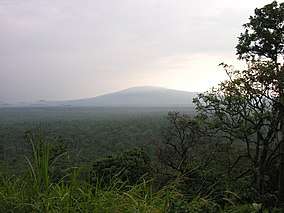 | |
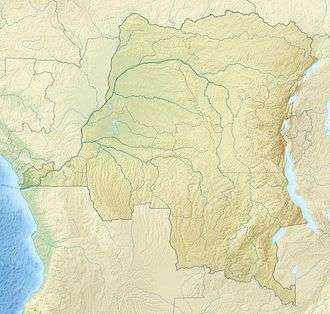 | |
| Location | Democratic Republic of the Congo |
| Nearest city | Goma |
| Coordinates | 0°55′S 29°10′E |
| Area | 7,768.93 km2 (2,999.60 sq mi)[1] |
| Established | April 1925 |
| Governing body | Institut Congolais pour la Conservation de la Nature[2] |
| Website | virunga |
| Criteria | Natural: (vii), (viii), (x) |
| Reference | 63 |
| Inscription | 1979 (3rd session) |
| Endangered | 1994–... |
| Official name | Parc National des Virunga |
| Designated | 18 January 1996 |
| Reference no. | 787[3] |
Two active volcanoes are located in the park, Mount Nyiragongo and Nyamuragira.[6] They have significantly shaped the national park's diverse habitats and wildlife. More than 3,000 faunal and floral species have been recorded, of which more than 300 are endemic to the Albertine Rift including eastern gorilla (Gorilla beringei) and golden monkey (Cercopithecus kandti).[7]
There have been several deadly attacks in the park by rebel groups, and several park rangers have been killed.[8][9]
History
In the early 1920s, several proponents of the European conservation movement championed the idea of creating a protected area in northeastern Belgian Congo, among them Victor van Straelen, Jean Massart and Jean-Marie Derscheid. When Albert National Park was established in April 1925 as Africa's first national park, it was conceived as a science-oriented nature reserve with the aim of studying and preserving wildlife and so-called ‘primitive’ hunter-gatherer African Pygmies. In 1926, Derscheid headed the first Belgian mission to cartograph Albert National Park, which encompassed an area of 500 km2 (190 sq mi) around the extinct volcanoes Mount Karisimbi and Mount Mikeno. The protected area was extended in 1929 by Virunga National Park, which encompassed the Virunga Mountains, parts of the Rutshuru Territory and the plains south of Lake Edward. Its initial size of 2,920.98 km2 (1,127.80 sq mi) was enlarged step by step in subsequent years.[10][11][12][13] Indigenous people lost their traditional land rights in this process, and were evicted from the protected area.[12][14] Between the late 1930s and 1955, an estimated 85,000 Rwandophone people were moved to nearby Masisi in North Kivu.[15]
In 1934, the Institut des Parcs Nationaux du Congo Belge was founded as the governing body for national parks in the Belgian Congo.[10] Between the early 1930s and 1961, several expeditions to Albert National Park were carried out by Belgian scientists, the second headed by Gaston-François de Witte. They studied and collected zoological specimens of wildlife for the Musée Royal d'Histoire Naturelle de Belgique;[16][17] explored the ethnic groups in this area;[18] studied volcanic activity,[19] and fossils.[20]
In the late 1950s, encroaching Tutsi herders and their cattle destroyed natural habitat inside the park up to an altitude of 3,000 m (9,800 ft), threatening the food base of the park's gorillas.[21]
Land laws were reformed in the 1960s after Belgian Congo became independent as the Republic of the Congo, and the land declared property of the state, much to the disadvantage of local people. Illegal hunting inside protected areas increased.[14] In 1969, the two parks were merged under the name Virunga National Park, which was declared a UNESCO World Heritage Site in 1979.[2]
Since the early 1990s, the protected area was impacted by political turmoil in the African Great Lakes region. Following the Rwandan genocide, thousands of refugees fled to the Kivu region, and the presence of military increased. The First and Second Congo Wars further destabilised the region. Anti-poaching patrols inside the park were obstructed, and park personnel and wildlife were killed.[5] About 850,000 refugees lived around the national park in 1994. Up to 40,000 people entered the park daily in search of firewood and food, and deforested huge areas.[22] In 1994, Virunga National Park was entered into the List of World Heritage in Danger.[5] In 1996, the national park was enlisted as a Ramsar site of international importance.[2]
In 2005, the European Commission (EC) recommended a public-private partnership between the country's government and the British non-governmental organisation African Conservation Fund. The latter organisation is responsible for park management since 2010; about 80% of management costs are subsidised by the EC. Park protection efforts were militarised in the following years to deter armed rebel groups and poachers from operating inside the park.[23]
In 2011, the British company Soco International was granted a concession for extracting crude oil in the surroundings of and in large parts of the national park. Government officials supported exploration activities by Soco International mission members, whereas park management opposed. In the course of increasing tensions, the park's chief warden, Emmanuel de Mérode, was assailed in April 2014.[23] Following international protests, the company stopped exploring activities and consented to refrain from starting similar operations in the vicinity of World Heritage sites.[24][25][26][27]
By 2016, four hydropower dams were constructed that provide electricity to small businesses and benefit more than 200,000 rural people.[28]
Armed conflict
After the Second Congo War was over, confrontations between park personnel and rebel groups continued; 80 park staff were killed between 1996 and 2003.[22] Several armed rebel groups operate in the park, including Democratic Forces for the Liberation of Rwanda and National Congress for the Defence of the People.[2] Latter controlled the Mikeno sector of Virunga National Park between December 2006 and January 2009.[29] They generate income by levying fees from local people for protecting prohibited activities inside the national park like poaching and clandestine fishing, logging, producing and smuggling charcoal, but also through armed robberies and kidnapping. In 2010, the United Nations Security Council estimated that the charcoal trade represents an annual value of US$28–30 million. Clashes also occur between park personnel and Mai-Mai militias in illegal settlements.[30]
Five rangers were killed in August 2017 near Lake Edward in a militia attack. Five rangers and a driver were killed in April 2018.[31] Since beginning of the armed conflict, armed groups killed 175 park rangers until April 2018.[32] In May 2018, a ranger was killed when defending two tourists who were kidnapped.[8] They were subsequently released unharmed. As a consequence, the park remained closed to visitors from June 2018[33] until February 2019.[34]
On 24 April 2020, at least 12 park rangers were killed by militiamen attacking a civilian convoy.[35]
Geography
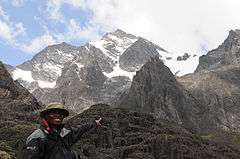
.jpg)
Virunga National Park is located in the Congo − Nile watershed area. Its northern sector encompasses part of the Semliki River basin, as well as savanna and montane forest of the Albertine Rift.[4] In altitude, this sector ranges from 680 m (2,230 ft) in the Puemba River valley to the highest peak of Mount Stanley at 5,109 m (16,762 ft) within 30 km (19 mi). The national park's central sector encompasses about two thirds of Lake Edward up to the international border with Uganda in the east. A narrow corridor of 3–5 km (1.9–3.1 mi) width along the lake's western bank connects the northern and southern sectors of the national park. The southern sector stretches to the shores of Lake Kivu and encompasses Nyamulagira, Nyiragongo and Mikeno volcanoes with montane forests on their slopes.[2]
The northern sector of Virunga National Park is contiguous with Uganda's Semuliki and Rwenzori Mountains National Parks, and the central sector with Queen Elizabeth National Park. The southern sector borders Rwanda's Volcanoes National Park.[36]
Climate
The climate in the Albertine Rift is influenced by the movement of the Intertropical Convergence Zone and the El Niño–Southern Oscillation. March to mid May and September to November are the main rainy seasons.[37] Mean monthly rainfall in the savanna around Lake Edward is 30–40 mm (1.2–1.6 in); this is the driest part of the landscape. The northern sector receives a monthly mean precipitation of up to 220 mm (8.7 in), and the southern sector of up to 160 mm (6.3 in).[36] Average temperatures in lower altitudes vary from 23–28 °C (73–82 °F), and in higher altitudes from 16–24 °C (61–75 °F), rarely dropping below 14 °C (57 °F).[11]
Biodiversity
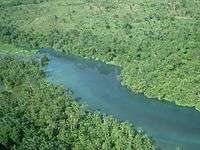

Plants
Virunga National Park's flora encompasses 2,077 plant species, including 264 tree species and 230 plants that are endemic to the Albertine Rift.[7] The plains of Virunga National Park are dominated by wetlands and grasslands with papyrus sedge (Cyperus papyrus), jointed flatsedge (C. articulatus), common reed (Phragmites mauritanica), sacaton grasses (Sporobolus consimilis), ambatch (Aeschynomene elaphroxylon), conkerberry (Carissa spinarum), paperbark thorn (Vachellia sieberiana) and kowai fruit (Coccinia grandis).[3][38] Remains of dicots such as African caper (Capparis tomentosa), Maerua species, wild cucurbits and nightshades were found in dung balls of African elephants (Loxodonta) that play a significant role for seed dispersal in the grasslands.[39]
The montane forest between 1,800 and 2,800 m (5,900 and 9,200 ft) in the southern sector is dominated by Ficalhoa laurifolia and Podocarpus milanjianus with up to 25 m (82 ft) high trees. African alpine bamboo (Yushania alpina) grows at altitudes of 2,300–2,600 m (7,500–8,500 ft). The vegetation above 2,600 m (8,500 ft) is subalpine with foremost African redwood (Hagenia abyssinica) growing up to 3,000 m (9,800 ft). Tree heath (Erica arborea), heather and mosses cover humid slopes up to 3,700 m (12,100 ft) altitude. Senecio and Lobelia species grow on vast clearings and attain heights of up to 8 m (26 ft).[11]
Animals
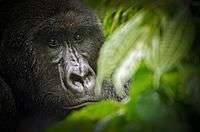
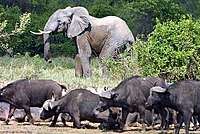
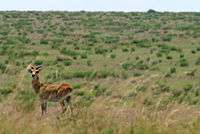
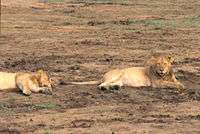
Virunga National Park's faunal species include 196 mammals, 706 bird species, 109 reptiles and 65 amphibians as of 2012.[7]
Mammals
Primates present in the national park include mountain gorilla (G. b. beringei), common chimpanzee (Pan troglodytes), golden monkey, red-tailed monkey (Cercopithecus ascanius), Dent's mona monkey (C. denti), blue monkey (C. mitis), Hamlyn's monkey (C. hamlyni), De Brazza's monkey (C. neglectus), Central African red colobus (Procolobus foai), mantled guereza (Colobus guereza), olive baboon (Papio anubis) and grey-cheeked mangabey (Lophocebus albigena).[7][17][40][41]
African bush elephant (Loxodonta africana), hippopotamus (Hippopotamus amphibius) and African buffalo (Syncerus caffer) inhabit the national park's central sector.[38] Okapi (Okapia johnstoni), blue duiker (Philantomba monticola), bay duiker (Cephalophus dorsalis), Weyns's duiker (C. weynsi), yellow-backed duiker (C. silvicultor), water chevrotain (Hyemoschus aquaticus), red river hog (Potamochoerus porcus), aardvark (Orycteropus afer) and bongo (Tragelaphus eurycerus) were recorded in the northern sector in 2008.[41] Harnessed bushbuck (T. scriptus) and giant forest hog (Hylochoerus meinertzhageni) are present in the southern sector.[40] Other ungulates present include Ugandan kob (Kobus kob thomasi), waterbuck (K. ellipsiprymnus), topi (Damaliscus lunatus jimela) and common warthog (Phacochoerus africanus).[36][42]
Virunga National Park together with the adjacent Queen Elizabeth National Park forms a 'Lion Conservation Unit'.[43] The area is considered a potential lion (Panthera leo) stronghold, if poaching is curbed and prey species recover.[42] In the national park's northern sector, African leopard (P. pardus pardus), marsh mongoose (Atilax paludinosus), giant pangolin (Smutsia gigantea), tree pangolin (Phataginus tricuspis), crested porcupine (Hystrix cristata), Lord Derby's scaly-tailed squirrel (Anomalurus derbianus), Boehm's bush squirrel (Paraxerus boehmi), western tree hyrax (Dendrohyrax dorsalis), Emin's pouched rat (Cricetomys emini) and checkered elephant shrew (Rhynchocyon cirnei) were recorded during surveys in 2008.[41]
Reptiles
The Semliki River provides habitat for Nile crocodile (Crocodylus niloticus). Several were observed at the northern shore of Lake Edwards in 1988 for the first time.[44]
Birds
Of the Albertine Rift's endemic birds, Rwenzori turaco, Rwenzori batis, Archer's ground robin, red-throated alethe, Kivu ground thrush, collared apalis, mountain masked apalis, dusky crimson-wing, Shelley's crimsonwing, red-faced woodland warbler, stripe-breasted tit, blue-headed sunbird, regal sunbird, Rwenzori double-collared sunbird, handsome spurfowl and strange weaver were recorded in Virunga National Park's southern sector during surveys in 2004. Non-endemic birds recorded include Wahlberg's eagle, African goshawk, African hobby, harrier hawk, common buzzard, mountain buzzard, hadeda ibis, grey-crowned crane, black-and-white-casqued hornbill, black-billed turaco, African olive pigeon, tambourine dove, blue-spotted wood dove, red-eyed dove, brown-necked parrot, red-chested cuckoo, olive long-tailed cuckoo, barred long-tailed cuckoo, Klaas's cuckoo, Diederik cuckoo, blue-headed coucal, Narina trogon, white-headed wood hoopoe, white-necked raven, white-tailed crested flycatcher, African paradise flycatcher, white-eyed slaty flycatcher, African dusky flycatcher, white-tailed blue flycatcher, mountain oriole, speckled mousebird, cinnamon-chested bee-eater, grey-throated barbet, yellow-billed barbet, western tinkerbird, yellow-rumped tinkerbird, cardinal woodpecker, olive woodpecker, black saw-wing, Angolan swallow, Alpine swift, mountain greenbul, yellow-whiskered greenbul, common bulbul, white-starred robin, Archer's ground robin, white-browed robin-chat, stonechat, rufous thrush, African thrush, olive thrush, grassland pipit, cinnamon bracken warbler, black-faced rufous warbler, mountain yellow warbler, brown woodland warbler, green sandpiper, Chubb's cisticola, banded prinia, chestnut-throated apalis, grey-backed camaroptera, white-browed crombec, black-throated wattle-eye, chinspot batis, mountain illadopsis, grey-chested illadopsis, olive sunbird, bronze sunbird, malachite sunbird, collared sunbird, variable sunbird, yellow white-eye, Mackinnon's shrike, Doherty's bushshrike, Lühder's bushshrike, northern puffback, mountain sooty boubou, tropical boubou, narrow-tailed starling, Sharpe's starling, baglafecht weaver, black bishop, grey-headed negrofinch, common waxbill, black-headed waxbill, bronze mannikin, black and white mannikin, pin-tailed whydah, African citril, streaky seedeater and thick-billed seedeater.[45]
Ethnic groups

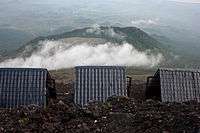
Ethnic groups living in and Virunga National Park include:
Media coverage
The documentary Virunga documents the work of Virunga National Park rangers and the activities of British oil company Soco International within the park. It was shown at international film festivals and released via the streaming service Netflix in November 2014.[47][48]
See also
References
- World Database on Protected Areas (2018). "Virunga National Park". Protected Planet, United Nations Environment World Conservation Monitoring Centre. Retrieved 17 December 2019.
- Crawford, A. & Bernstein, J. (2008). MEAs, Conservation and Conflict – A case study of Virunga National Park, DRC. Geneva: International Institute for Sustainable Development.
- Secrétariat Général à l'Environnement et Conservation de la Nature (1994). "Parc national des Virunga". Ramsar Sites Information Service. Retrieved 25 April 2018.
- Mubalama, L. & Mushenzi, N. (2004). "Monitoring law enforcement and illegal activities in the northern sector of the Parc National des Virunga, Democratic Republic of Congo". Pachyderm (36): 16–29.
- Debonnet, G. & Hillman-Smith, K. (2004). "Supporting protected areas in a time of political turmoil: the case of World Heritage Sites in the Democratic Republic of Congo". Parks. 14 (1): 9–16.
- Tedesco, D. (2002). "1995 Nyiragongo and Nyamulagira activity in the Virunga National Park: A volcanic crisis". Acta Vulcanologica. 14 (1/2): 149–155.
- Plumptre, A. J.; Davenport, T. R.; Behangana, M.; Kityo, R.; Eilu, G.; Ssegawa, P.; Ewango, C.; Meirte, D.; Kahindo, C.; Herremans, M. & Peterhans, J. K. (2007). "The biodiversity of the Albertine Rift". Biological Conservation. 134 (2): 178–194. doi:10.1016/j.biocon.2006.08.021.
- Actman, J. (2018). "Virunga National Park Sees Its Worst Violence in a Decade, Director Says". National Geographic News. Retrieved 27 April 2020.
- "Twelve rangers killed in latest Virunga Park incident". Mongabay Environmental News. 2020. Retrieved 27 April 2020.
- Harroy, J.P. (1993). "Contribution à l'histoire jusque 1934 de la création de l'Institut des parcs nationaux du Congo belge". Civilisations. Revue internationale d'anthropologie et de sciences humaines. 41: 427–442. doi:10.4000/civilisations.1732.
- Bashonga, M. G. (2012). Etude socio-économique et culturelle, attitude et perceptions des communautés Twa pygmées autour du secteur Mikeno du Parc National des Virunga. Goma: Institut Congolais pour la Conservation de la Nature.
- De Bont, R. (2015). ""Primitives" and Protected Areas: International Conservation and the "Naturalization" of Indigenous People, ca. 1910-1975". Journal of the History of Ideas. 76 (2): 215–236. doi:10.1353/jhi.2015.0014.
- De Bont, R. (2017). "A World Laboratory: Framing the Albert National Park". Environmental History. 22 (3): 404–432. doi:10.1093/envhis/emx020.CS1 maint: uses authors parameter (link)
- Inogwabini, B.I. (2014). "Conserving biodiversity in the Democratic Republic of Congo: a brief history, current trends and insights for the future". Parks. 20 (2): 101−110. doi:10.2305/iucn.ch.2014.parks-20-2.bi.en.
- Stephen J. (2007). "Of "Doubtful Nationality": Political Manipulation of Citizenship in the D. R. Congo". 11 (5): 481–500. doi:10.1080/13621020701605792. Cite journal requires
|journal=(help) - Schouteden, H. (1938). Exploration du Parc National Albert: Oiseaux (PDF). Bruxelles: Institut des Parcs Nationaux du Congo Belge.
- Frechkop, S. (1943). Exploration du Parc National Albert: Mammifères (PDF). Bruxelles: Institut des Parcs Nationaux du Congo Belge.
- Schumacher, P. (1943). Die Kivu-Pygmäen und ihre soziale Umwelt im Albert-National Park (PDF). Bruxelles: Institut des Parcs Nationaux du Congo Belge.
- Verhoogen, J. (1948). Les éruptions 1938-1940 du volcan Nyamuragira (PDF). Bruxelles: Institut des Parcs Nationaux du Congo Belge.
- de Heinzelin de Braucourt, J. (1961). Le paléolithique aux abords d'Ishango (PDF). Bruxelles: Institut des Parcs Nationaux du Congo Belge.
- Dart, R.A. (1960). "The urgency of international intervention for the preservation of the mountain gorilla". South African Journal of Science. 56 (4): 85–87.
- McNeely, J.A. (2003). "Conserving forest biodiversity in times of violent conflict". Oryx. 37 (2): 142–152. doi:10.1017/S0030605303000334.
- Marijnen, E. (2018). "Public Authority and Conservation in Areas of Armed Conflict: Virunga National Park as a 'State within a State' in Eastern Congo". Development and Change. 49 (3): 790–814. doi:10.1111/dech.12380.
- Nkongolo, J.K. (2015). "International solidarity and permanent sovereignty over natural resources: antagonism or peaceful coexistence? The case of oil in the Virunga National Park". African Journal of Democracy and Governance. 2 (3–4): 77–98.
- Verheyen, E. (2016). "Oil extraction imperils Africa's Great Lakes". Science. 354 (6312): 561–562. doi:10.1126/science.aal1722. hdl:1942/23763.
- Hochleithner, S. (2017). "Beyond Contesting Limits: Land, Access, and Resistance at the Virunga National Park". Conservation and Society. 15 (1): 100–110. doi:10.4103/0972-4923.201397.
- Kümpel, N.F., Hatchwell, M., Clausen, A., Some, L., Gibbons, O. and Field, A. (2018). "Sustainable development at natural World Heritage sites in Africa" (PDF). In Moukala, E. and Odiaua, I. (eds.). World Heritage for Sustainable Development in Africa. Paris: United Nations Educational, Scientific and Cultural Organization. pp. 51–61.CS1 maint: uses authors parameter (link) CS1 maint: uses editors parameter (link)
- Odiaua, I. and Moukala, E. (2018). "Engaging World Heritage to drive sustainable development in Africa: next steps" (PDF). In Moukala, E. and Odiaua, I. (eds.). World Heritage for Sustainable Development in Africa. Paris: United Nations Educational, Scientific and Cultural Organization. pp. 251–277.CS1 maint: uses authors parameter (link) CS1 maint: uses editors parameter (link)
- Refisch, J. and Jenson, J. (2016). "Transboundary collaboration in the Greater Virunga Landscape: From gorilla conservation to conflict-sensitive transboundary landscape management". In Bruch, C., Muffett, C., Nichols, S.S. (eds.). Governance, Natural Resources, and Post-Conflict Peacebuilding. Oxon, New York: Routledge. pp. 825–841. ISBN 1136272070.CS1 maint: uses authors parameter (link) CS1 maint: uses editors parameter (link)
- Verweijen, J. and Marijnen, E. (2016). "The counterinsurgency/conservation nexus: guerrilla livelihoods and the dynamics of conflict and violence in the Virunga National Park, Democratic Republic of the Congo" (PDF). The Journal of Peasant Studies. 45 (2): 300–320. doi:10.1080/03066150.2016.1203307.CS1 maint: uses authors parameter (link)
- Burke, J. (2018). "Six Virunga park rangers killed in DRC wildlife sanctuary". The Guardian. Retrieved 10 April 2018.
- "In memoriam: deadliest attack on Virunga staff in Park's recent history brings total ranger deaths to 175". Virunga. 2018. Retrieved 2018-08-17.
- "Virunga Park Closure Statement" (PDF). 2018.
- Prentice, A. (2019). "Congo's Virunga park reopens eight months after deadly ambush". Reuters. Retrieved 2019-04-26.
- "Rangers killed in 'deadliest' DR Congo park attack". BBC News. 2020. Retrieved 27 April 2020.
- Plumptre, A. J., Pomeroy, D., Stabach, J., Laporte, N., Driciru, M., Nangendo, G., Wanyama, F. and Rwetsiba, A. (2012). "The effects of environmental and anthropogenic changes on the savannas of the Queen Elizabeth and Virunga National parks". In Plumptre, A. J. (ed.). Long Term changes in Africa’s Rift Valley: impacts on biodiversity and ecosystems. New York: Nova Science Publishers. pp. 88–105.CS1 maint: uses authors parameter (link)
- Seimon, A. and Phillipps, G. P. (2012). "Regional Climatology of the Albertine Rift". In Plumptre, A. J. (ed.). Long Term changes in Africa’s Rift Valley: impacts on biodiversity and ecosystems. New York: Nova Science Publishers. pp. 18–38.CS1 maint: uses authors parameter (link)
- Mubalama, L. (2000). "Population and Distribution of Elephants (Loxodonta africana africana) in the Central Sector of the Virunga National Park, Eastern DRC". Pachyderm. 28: 44–55.
- Brahmachary, R.L. (1980). "On the germination of seeds in the dung balls of the African elephant in the Virunga National Park" (PDF). Revue d'Ecologie La Terre et la Vie. 34 (1): 139–142.
- Lanjouw, A. (2002). "Behavioural adaptations to water scarcity in Tongo chimpanzees". In Boesch, C., Hohmann, G., Marchant, L. (eds.). Behavioural diversity in Chimpanzees and Bonobos. Cambridge: Cambridge University Press. pp. 52–60. ISBN 0521006139.CS1 maint: uses editors parameter (link)
- Nixon, S. C. Lusenge, T. (2008). Conservation status of okapi in Virunga National Park, Democratic Republic of Congo. ZSL Conservation Report No. 9 (PDF). London: The Zoological Society of London.CS1 maint: uses authors parameter (link)
- Treves, A.; Plumptre, A. J.; Hunter, L. T. B.; Ziwa, J. (2009). "Identifying a potential lion Panthera leo stronghold in Queen Elizabeth National Park, Uganda, and Parc National des Virunga, Democratic Republic of Congo". Oryx. 43 (1): 60–66. doi:10.1017/S003060530700124X.
- IUCN Cat Specialist Group (2006). Conservation Strategy for the Lion Panthera leo in Eastern and Southern Africa. Pretoria, South Africa: IUCN.
- Verschuren, J. and Kitsidikiti, L. (1989). "L'apparition des crocodiles au lac ex-Edouard, Parc National des Virunga, Zaïre" (PDF). Revue d'Ecologie La Terre et la Vie. 44 (4): 367–397.CS1 maint: uses authors parameter (link)
- Owiunji, I., Nkuutu, D., Kujirakwinja, D., Liengola, I., Plumptre, A., Nsanzurwimo, A., Fawcett, K., Gray, M. & McNeilage, A. (2005). Biological Survey of Virunga Volcanoes (PDF). New York: Wildlife Conservation Society.CS1 maint: uses authors parameter (link)
- Hart, T.B. and Hart, J.A. (1986). "The ecological basis of hunter-gatherer subsistence in African rain forests: the Mbuti of Eastern Zaire". Human Ecology. 14 (1): 29–55. doi:10.1007/bf00889209.CS1 maint: uses authors parameter (link)
- "Screenings". Virunga (Official Website). Retrieved 20 August 2014.
- Sinha-Roy, Pifa (6 November 2014). "Netflix's 'Virunga' uncovers Congo's fight to protect resources". Reuters. Los Angeles. Retrieved 8 November 2014.
External links
| Wikimedia Commons has media related to Virunga National Park. |
| Wikivoyage has a travel guide for Virunga National Park. |
- Official website
- "Virunga National Park - UNESCO World Heritage List". UNESCO World Heritage Centre. UNESCO. Retrieved 22 January 2016.
- BirdLife International. "Important Bird Areas factsheet: Virunga National Park".
- "Interview With Emmanuel de Merode, Director of Virunga National Park – National Geographic Blog". blog.nationalgeographic.org. May 2017. Retrieved 2017-12-21.
- "Congolese Wildlife Authority ICCN".
- "Visit Virunga National Park".
- "UNEP-WCMC Natural Site Data Sheet" (PDF).
- "UNESCO Virunga National Park Site".
- "National Geographic Channel".
- "Inside the Fight to Save a Dangerous Park". National Geographic Magazine 230 (1). July 2016. Retrieved 2017-09-11.
- "'Oil threat' to DR Congo's Virunga National Park". BBC Online. BBC News. July 2013. Retrieved 2 August 2013.
- "Oil Dispute Takes a Page From Congo's Bloody Past". 2014. Retrieved 2014-11-19.